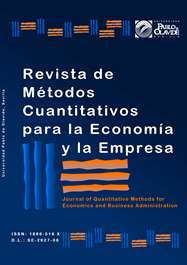Métodos cuantitativos para un modelo de regresión lineal con multicolinealidad. Aplicación a rendimientos de letras del tesoro
DOI:
https://doi.org/10.46661/revmetodoscuanteconempresa.2886Palabras clave:
modelos de regresión, multicolinealidad, regresión alzada, regresión cresta, regresión con variables ortogonales, regression models, multicollinearity, raised regression, ridge regression, regression with orthogonal variablesResumen
Es conocido que, cuando en el modelo de regresión lineal existe un alto grado de multicolinealidad, los resultados obtenidos a partir del método de mínimos cuadrados ordinarios (MCO) son inestables. Como solución a esta situación, en este trabajo se presentan los métodos de alzado, cresta y variables ortogonales como alternativa a la estimación por MCO. También se muestra que la regresión con variables ortogonales tiene sentido independientemente de la existencia de multicolinealidad grave, ya que permite dar respuesta a cuestiones no accesibles con el modelo original. Dichas metodologías se aplican a un conjunto de datos de rendimientos de letras del tesoro.
Descargas
Citas
Belsley, D.A. (1982). "Assessing the presence of harmful collinearity and other forms of weak data through a test for signal-to-noise". Journal of Econometrics, 20, 211-253.
García, C.B.; García, J.; López Martín, M.M. y Salmerón, R. (2015). "Collinearity: revisiting the variance inflation factor in ridge regression". Journal of Applied Statistics, 42(3), 648-661.
García, C.; Salmerón, R.; García, J. y López, M.M. (2016). "Estimación cresta y alzada: selección de $k$ y $lambda$ a partir del coeficiente de correlación". Anales de Economía Aplicada, XXX, 949-955.
García, J.; Salmerón, R.; García, C. y López Martín, M.M. (2016): "Standardization of Variables and Collinearity Diagnostic in Ridge Regression". International Statistical Review, 84(2), 245-266.
Marquardt, D.W. (1970). "Generalized inverses, ridge regression, biased linear estimation and nonlinear estimation''. Technometrics, 12(3), 591-612.
McDonald, G.C. (2010). "Tracing ridge regression coefficients". Wiley Interdisciplinary Reviews: Computational Statistics, 2, 695-703.
Novales, A. (1993). Econometría. McGraw-Hill, 2ª edición.
Novales, A.; Salmerón, R.; García, C.; García, J. y López, M.M. (2015). "Tratamiento de la multicolinealidad aproximada mediante variables ortogonales". Anales de Economía Aplicada, XXIX, 1212-1227.
O’Brien, R.M. (2007). "A caution regarding rules of thumb for variance inflation factors". Quality and Quantity, 41, 673–690.
Salmerón, R.; García, C.; García, J. y López, M. M. (2017). "The raise estimators. Estimation, inference and properties". Communications in Statistics-Theory and Methods, 46(13), 6446-6462.
Spanos, A. y McGuirk, A. (2002). "The problem of near-multicollinearity revisited: erratic vs systematic volatily". Journal of Econometrics, 108 (2), 365-393.
Zhang, J. e Ibrahim, M. (2005). "A simulation study on SPSS ridge regression and ordinary least squares regression procedures for multicollinearity data". Journal of Applied Statistics, 32(6), 571-588.
Descargas
Publicado
Cómo citar
Número
Sección
Licencia
Derechos de autor 2017 Revista de Métodos Cuantitativos para la Economía y la Empresa

Esta obra está bajo una licencia internacional Creative Commons Atribución-CompartirIgual 4.0.
El envío de un manuscrito a la Revista supone que el trabajo no ha sido publicado anteriormente (excepto en la forma de un abstract o como parte de una tesis), que no está bajo consideración para su publicación en ninguna otra revista o editorial y que, en caso de aceptación, los autores están conforme con la transferencia automática del copyright a la Revista para su publicación y difusión. Los autores retendrán los derechos de autor para usar y compartir su artículo con un uso personal, institucional o con fines docentes; igualmente retiene los derechos de patente, de marca registrada (en caso de que sean aplicables) o derechos morales de autor (incluyendo los datos de investigación).
Los artículos publicados en la Revista están sujetos a la licencia Creative Commons CC-BY-SA de tipo Reconocimiento-CompartirIgual. Se permite el uso comercial de la obra, reconociendo su autoría, y de las posibles obras derivadas, la distribución de las cuales se debe hacer con una licencia igual a la que regula la obra original.
Hasta el volumen 21 se ha estado empleando la versión de licencia CC-BY-SA 3.0 ES y se ha comenzado a usar la versión CC-BY-SA 4.0 desde el volumen 22.










